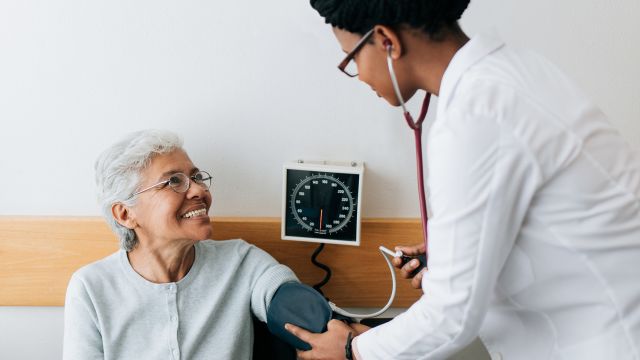Blood pressure that’s usually normal but becomes elevated in the doctor’s office is a possible warning sign of heart trouble that shouldn’t be ignored.
This phenomenon, known as “white coat hypertension” (since doctors typically wear white lab coats), was once generally dismissed as a temporary issue related to the stress or anxiety of a doctor visit. But a growing body of evidence challenges this view, suggesting that untreated white coat high blood pressure is linked to an increased risk for heart attack and early death.
An analysis of 27 observational studies, involving more than 64,000 people who were followed for three to 19 years, found that those with untreated white coat hypertension were twice as likely to die from heart disease than people with normal blood pressure. They were also much more likely to have a heart-related event, particularly if they were older and had other risk factors for heart disease.
The analysis, published in June 2019 in Annals of Internal Medicine, also found that people who had white coat high blood pressure despite receiving treatment for hypertension were not at higher risk of death from heart disease. The researchers concluded that those who experience episodes of high blood pressure in the doctor’s office should adopt heart-healthy lifestyle habits, including following a healthy diet, exercising regularly, maintaining a healthy weight, curbing alcohol intake, and not smoking. They also pointed to a need for more widespread use of out-of-office blood pressure screening, also known as ambulatory blood pressure monitoring.
Signs of a larger health issue
Doctors have long worried that white coat hypertension could lead to unnecessary treatment. If a patient is diagnosed with high blood pressure at the doctor's office, they may be given medications to lower it, when in fact their blood pressure is normal.
But mounting research suggests white coat hypertension shouldn’t be ignored. A separate 2018 Spanish study of more than 63,000 mostly white patients found that when compared to those with steadily normal blood pressure, people who experienced the white coat effect had a 79 percent higher risk of death.
Why might this be the case? The reasoning goes that white coat hypertension may signal that a person is prone to stress, which can have an effect on heart health. If a patient's blood pressure is affected by the anxiety of seeing a physician, it's likely affected by many other factors.
Expert panels, including the U.S. Preventive Services Task Force (USPSTF), recommend out-of-office blood pressure screening to confirm a diagnosis of white coat hypertension before treatment for high blood pressure begins.
Monitoring blood pressure at home
At-home blood pressure monitoring is a good way to be actively involved in keeping your blood pressure under control. It may also provide a more accurate picture of your blood pressure than occasional measurements taken at the doctor's office. Studies show that home measurements, when taken correctly, are better predictors of cardiovascular risk than office measurements.
Home monitoring can help determine whether a high blood pressure reading is accurate or is simply a result of the white coat effect. There are other benefits as well.
Self-monitoring may also be used to help assess how well medications or lifestyle modifications are working. And there is evidence to suggest that home monitoring may help people reduce their blood pressure. The best way to monitor high blood pressure at home, according to the USPSTF, is to wear a portable monitor for 12 to 24 hours after having an in-office test. It will take your blood pressure every 20 to 30 minutes—even when you're asleep.
Once you’ve measured, you can keep track of your systolic and diastolic numbers using the Sharecare app (available through iOS and Android). Convenient and easy to use, it tells you whether your reading is healthy, and helps you recognize changes over time—important for detecting conditions like hypertension.
Choose the right blood pressure monitoring device
There are so many devices on the market for measuring blood pressure at home that it can be difficult to know which one to choose. Most people who measure their blood pressure at home use an automatic machine with a digital display. Many find that these devices are easy to use. The cuff inflates and deflates automatically, the numbers are clear and easy to read, and many machines can store and print multiple blood pressure readings. But they do have their downsides. Some are made for use on the left arm only, and they can be expensive.
Here are a few simple guidelines to help you choose the right blood pressure monitoring device:
- Choose a device that measures blood pressure from your upper arm. Wrist and finger monitors are not accurate.
- Choose a monitor with a display that's easy for you to read.
- A monitor that can save, download, and print your readings is best for accurate record-keeping.
Before you buy, verify that the monitor you're considering has been independently tested, validated, and approved for home use.
Once you've bought a measuring device, make an appointment with your doctor and take the device with you. That way, if you have any questions about home monitoring or how to read blood pressure numbers, your doctor can provide guidance. Also, some monitors need to be calibrated or checked for accuracy on a regular basis. Your doctor should be able to do this for you.
For more detailed information on choosing and using a home blood pressure monitor, check out information from the American Heart Association.
Keeping an eye on your blood pressure is an easy and effective way to monitor your health and prevent high blood pressure from sneaking up on you.






